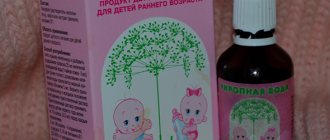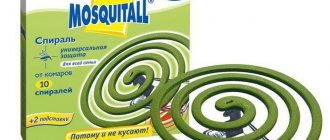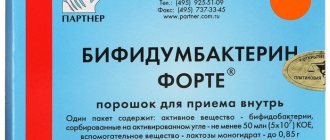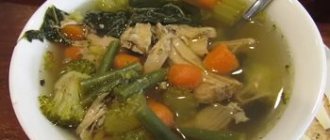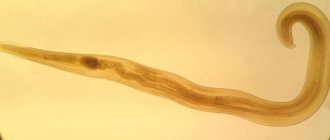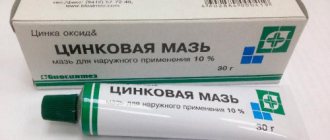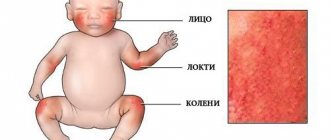What kind of drug is this?
Many inflammatory processes in the upper respiratory tract are accompanied by dilation of small vessels. Nazol baby belongs to the category of vasoconstrictor drugs that eliminate such symptoms. It is recommended to use drops not only in the presence of rhinitis of various etiologies, but also as a preventive measure for congestion in the nasal sinuses before or after surgery.
Features of the drug:
- the components included in the drops are not absorbed into the bloodstream;
- the drug does not provoke morphological or functional disorders of the nasal mucous membranes, even with long-term use;
- The effect of using drops occurs within a few minutes.
Decongestants for children
1. Children in the first months of life often sniffle. This is either a physiological narrowness of the nasal passages, or the mother did not clean the child’s nose well. Do not rush to recommend a vasoconstrictor drug. Ask about other symptoms. If it is ARVI, there will definitely be something else: the baby is capricious, refuses to eat, coughs, and the temperature may rise.
2. In children, the nasal mucosa is thinner, the blood supply is more intense, so they develop systemic effects faster and are more pronounced: nausea, vomiting, anxiety, etc.
3. Strictly follow the children's dosage. It is possible to offer children's drops to an adult, but vice versa - not.
In children, both drugs can be used for no more than 3 days in a row. In general, oxymetazoline (Nasivin) will be more effective at any age. A study was conducted in the USA that compared its effect with phenylephrine in children. The latter more often caused a decrease in heart rate or an increase in blood pressure. Therefore, when choosing between Nazol or Nazivin, children under two years of age are better off using Nazivin drops.
Mechanism of action
The components that make up Nazol baby constrict blood vessels in the nasal cavity and affect the state of receptors located in the smooth muscle layer. Thanks to this effect, swelling decreases and breathing is significantly easier . The action of the drug is aimed at the mucous membranes, Eustachian tube and paranasal sinuses.
The mechanism of action of the drug consists of the following properties:
- improved breathing;
- reducing tissue swelling;
- thickening of vascular walls;
- increased vascular tone in the nasal sinuses;
- preventing dry mucous membranes;
- impact on the focus of the inflammatory process;
- increased drainage of the paranasal sinuses;
- improvement of the child's general condition.
Composition and release forms
Nazol baby is available in the form of drops .
The bottle volume can be 5, 10, 15 or 30 ml. The tube is additionally placed in a cardboard box. Regardless of the name of the manufacturer and the volume of the bottle, the active substance is always finylephrine hydrochloride.
This component is supplemented with auxiliary elements that enhance its effect.
The auxiliary components in the composition of the drug are the following substances:
- purified water;
- benzalkonium chloride;
- potassium dihydrogen phosphate;
- glycerol;
- disodium edetate dihydrate;
- sodium hydrogen phosphate dihydrate.
What is the difference?
Let's start with the most important thing, namely the main active ingredients. In the entire Nazivin line, the active substance is oxymetazoline
in different dosages. Today it can be called the fastest-acting and long-lasting means of facilitating nasal breathing. True, nothing comes for free, and oxymetazoline is not the safest adrenergic agonist for the mucous membrane and becomes addictive quite quickly. Therefore, it is not recommended to use any oxymetazoline preparations for more than 3-5 days in a row.
The advantage of the German Nazivin is a wide selection of options and forms for different ages, there are 6 in total.
Differences between Nazivin drugs
| Form | Age | Amount of oxymetazoline |
| drops | up to a year | 0.01% |
| 1-6 years | 0,025% | |
| drops | from 6 years | 0,05% |
| spray | ||
| Sensitive (spray) | from one year to 6 years | 11.25 mg/dose |
| from 6 years | 22.5 mg/dose |
The table shows that there are 3 types of drops and 3 types of sprays in the line, two of them with the prefix “Sensitive” in the name. Sensitive differs from regular Nazivin in two useful advantages:
- a more precise dispenser mechanism that measures each injection down to the microgram, which eliminates the possibility of overdose;
- The excipient in the solution - the preservative benzalkonium chloride -
has been replaced with glycerol. The manufacturer positions these forms as a gentle option for people with sensitive nasal mucosa prone to allergic reactions. However, the harm and irritation from benzalkonium are exaggerated in advertising. Research shows that this preservative, although cytotoxic, rarely has a negative effect on the ciliated epithelium in low concentrations, being neutralized by nasal secretions. But if there is a “softer” alternative in the form of glycerol, then this is certainly better.
Nazol is also a German drug, but produced by another company (Bayer). Forms for adults, like the opponent, contain oxymetazoline as the main substance, but in a slightly higher concentration (see table below). But the main component of children's forms is what distinguishes Nazol from Nazivin. They use phenylephrine as a vasoconstrictor. This is also an adrenomimetic, but acting on other alpha receptors. Its difference from oxymetazoline is that it does not have such a long-lasting effect, which may require more frequent use. But when used intranasally, it is not so strongly absorbed into the bloodstream, which may be better for infants.
For adults, Nazol will be better as an emergency measure or short-term symptomatic treatment of severe congestion due to allergies or hay fever.
The product line has fewer options than its competitor, there are 4 in total.
Differences between Nazol drugs
| Form | Age | Quantity of active substance |
| "Baby" (drops) | from 0 years (up to a year strictly as prescribed by the doctor) | phenylephrine - 0.125% |
| "Kids" (drops) | from 4 years | phenylephrine - 0.25% |
| Spray | from 6 years | oxymetazoline - 25 mcg/dose |
| "Advance" (spray) |
Nazol "Kids" and "Advance" in addition to the main components additionally contain eucalptol
. This is an artificial essential oil with a slight antiseptic effect and a characteristic eucalyptus scent.
Indications for use
Nazol baby is used to treat runny nose of any etiology. The drug can be used for children from birth. Drops help speed up the healing process for various diseases accompanied by rhinitis. They can be used for the treatment of infectious lesions of the respiratory tract, of both known and unspecified nature.
Indications for the use of Nazol baby drops are the following conditions:
- colds;
- acute respiratory infections and acute respiratory viral infections;
- sinusitis;
- otitis;
- flu;
- rhinitis, regardless of etiology;
- allergic rhinitis;
- acute nasopharyngitis;
- other diseases accompanied by nasal congestion.
Baby nose drops
Medicines intended for children are most often produced with the baby label. Among these are nasal drops that can relieve nasal congestion and improve nasal breathing in a child. These drugs differ in a smaller dosage of the active substance compared to the usual one.
For comparison, we can highlight the two most frequently prescribed drugs by doctors: Nazivin for children and Nazol Baby. The principle of action and duration of the effect of these drops are the same, but otherwise there are certain differences.
Contraindications and side effects
Side effects from the use of Nazol baby may occur due to individual intolerance to the components included in the drug.
The child may experience a burning or tingling sensation in the nose, rapid heartbeat, or abnormal blood pressure. There is no data on an overdose of the drug in medical practice, but excessive use of drops can cause tremors of the limbs, sweating and sleep disturbances.
The following conditions are contraindications for the use of the drug:
- diabetes;
- serious pathologies of the cardiovascular system;
- acute forms of hepatitis;
- thyrotoxicosis;
- hypersensitivity of the body to the components of the drug;
- high blood pressure;
- pancreatitis at any stage of development;
- chronic kidney disease;
- pathologies of the thyroid gland;
- hypertensive crisis.
In rare cases, Nazol baby can provoke an allergic reaction in the child’s body. This condition is accompanied not only by characteristic rashes on the skin, but also by increased body temperature, shortness of breath and increased symptoms of the existing disease. If these signs appear, use of the drug should be discontinued . If the child's condition does not improve within a few days, it is recommended to consult a doctor.
Directions for use and dosage for children
The recommended course of treatment with Nazol baby is three days. If after this period there is no improvement in the child’s condition, then it is necessary to consult a specialist. The lack of effect may be due to the presence of serious complications of the existing disease or incorrect selection of medications.
Scheme for using the drug for children:
- for children from birth to one year, the drug is prescribed one drop into each nasal passage three times a day (the interval between instillations should not be less than six hours);
- for children from one year to six years, the dosage is increased to two drops in each nasal passage three times a day;
- For children over six years of age, the drug can be instilled three or four drops several times a day.
special instructions
Nazol baby should not be used under any circumstances if there are contraindications.
The drug can provoke not only a deterioration in the child’s condition, but also cause an exacerbation of existing diseases. If drops are used as an addition to complex therapy, then before using them you must agree on the list of medications with your doctor.
Drops do not combine with some medications and may interfere with their effectiveness.
Special instructions for the use of Nazol baby are the following recommendations:
- Drops should not be used in combination with drugs that have vasoconstrictor properties;
- Drops can be used two weeks after therapy with monoamine oxidase inhibitors;
- before using drops for children under six years of age, it is recommended to consult a pediatrician;
- the drug cannot be combined with tricyclic antidepressants;
- an overdose of the drug is possible only if the dosages specified in the instructions are repeatedly and significantly exceeded;
- after each use of the pipette, it must be washed with water and dried;
- The risk of side effects from drops in children is higher than in adult patients.
Can decongestants be used by pregnant women?
In preparation for this conversation, I analyzed about 50 instructions, and what is surprising: even if the drugs contain the same active ingredient, the recommended course of use is different. Perhaps it depends on the excipients.
For example, the instructions for the drug Nazol say that it can be used for no more than 3 days. And in the instructions for the drug Afrin - no more than 7, although both Oxymetazoline.
But let's be realistic. Nasal congestion is unlikely to go away in 3 days. But in 7 it’s really possible to cope with it. And this is the period during which addiction will not develop.
Therefore, on average, it is recommended to use them for no more than 7 days.
It’s better not to, because when absorbed into the blood, even in minimal quantities, they cause spasm of the blood vessels of the placenta. Less blood will flow through the narrowed vessels to the fetus, and it will experience oxygen starvation.
As a last resort, the minimum pediatric dosages are prescribed.
Analogs
Almost all drops for nasal use with a vasoconstrictor effect have similar pharmacological properties to Nazol baby. The composition of such drugs, the list of contraindications and the regimen for children may differ. When selecting medications for the treatment of rhinitis, it is important to take into account the age of the child . The price of analogues may differ from Nazol baby.
The following drugs are considered analogues of Nazol baby:
- Nazol;
- Vibrocil;
- Aqualor baby;
- Irifrin;
- Otrivin baby.
Patient reviews
Maxim, 33 years old, Nizhny Novgorod: “I’ve been using Nazivin for more than 5 years. Helps quickly get rid of nasal congestion. The medicine attracts with its reasonable price. Nasal congestion goes away within 60 seconds and allows you to breathe easily for another 3-4 hours.”
Kristina, 25 years old, Volgograd: “Nazivin are high quality drops that have been tested during illnesses more than once. I treat my youngest daughter only with Nazivin during colds, because I noticed that it helps her breathe easily faster than other drops, and its effect lasts a long time. The medicine is common and can be bought at almost any pharmacy. The only disadvantage of the drug is its price, because there are cheaper children's drops. But when it comes to the child’s health, I think it’s better not to save money.”
Olga, 29 years old, Rostov-on-Don: “I have a lot of experience using various drops; due to problems with the septum, I have to help my breathing in this way every day. Nazol helps well, but there are also disadvantages. The annotation states that the effect lasts more than 10 hours, but re-application is necessary after 3 hours. To avoid the vasoconstrictor effect, I alternate drops with spray. Long-term use without a break can lead to addiction.”
What's better?
Nazol baby or Nazivin
Nazivin belongs to the group of analogues of Nazol baby, but the concentration of the components included in its composition is weaker. This nuance does not affect the effectiveness of the drug. Nazivin is often prescribed as an alternative if a child has an allergic reaction to Nazol or there are contraindications. Both drugs are vasoconstrictors.
Vibrocil or Nazol baby
Vibrocil is considered one of the analogues of Nazol baby, but the pharmacological properties of this drug are much broader.
It is prescribed as an additional remedy in the treatment of allergic rhinitis. Both drugs can be used for children from birth.
Vibrocil is available not only in the form of drops, but also as a spray or gel. For infants, these forms are more convenient to use.
What are the types of vasoconstrictors?
1. Short-acting drugs. Their action lasts 4-6 hours.
With the active ingredient Naphazolin: Naphthyzin, Sanorin.
With the active ingredient Phenylephrine: Nazol Kids, Nazol Baby, Vibrocil.
2. Medications with an average duration of action. Valid for 8-10 hours. These are products with the active ingredient Xylometazoline (there are a lot of them, we’ll look at them in more detail later), with the active ingredient Tramazolin: Lazolvan Rino.
3. Long-acting drugs. They work 10-12 hours. Preparations with the active ingredient Oxymetazoline. There is also a carriage and a small cart. We'll talk about them ahead.
It has been established that Naphazolin has the greatest toxic effect on ciliated epithelial cells, which cleanse the nasal mucosa of harmful impurities, viruses, bacteria, and excess mucus.
Xylometazoline preparations are indicated only from 2 years of age. Most often they are the ones that cause addiction.
Oxymetazoline-based products can be prescribed from the neonatal period (depending on the brand). These drugs, to a lesser extent than others, disrupt mucociliary clearance, a mechanism for protecting the nasal mucosa from external enemies.
1. Monopreparations with only one active ingredient: Afrin, Dlynos, Xylen, Nazivin, Nazol, Otrivin, etc.
2. Combination drugs containing more than one active ingredient. Precisely the ACTIVE one.
I draw attention to this because in some publications you can see that combination products are considered to be those that contain certain excipients that improve the consumer properties of the drug.
For example, menthol (levomenthol) and eucalyptus, or more precisely, cineole, a substance contained in eucalyptus oil, are listed in the excipients. But they also contribute their 2 cents to the medicinal properties of a particular drug.
Combined tools allow you to solve a wider range of problems.
For example, Vibrocil not only relieves nasal congestion, but also has an antiallergic effect, because it also contains an antihistamine component. For allergic rhinitis, it will be more effective than a single drug of this group.
Or Otrivin Complex. It contains Xylometazoline and Ipratropium bromide. The first constricts blood vessels, the second reduces mucus secretion. Therefore, it is especially good for a combination of nasal congestion and runny nose.
We'll talk more about the "chips" later.
